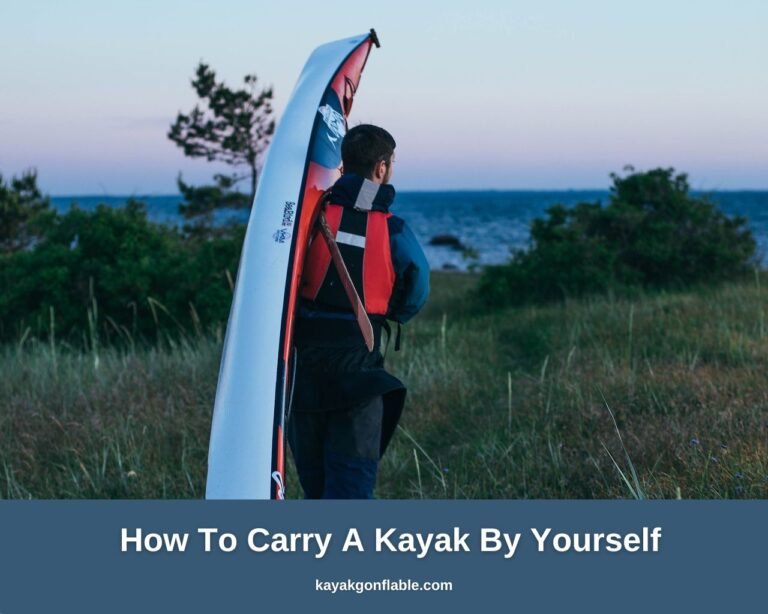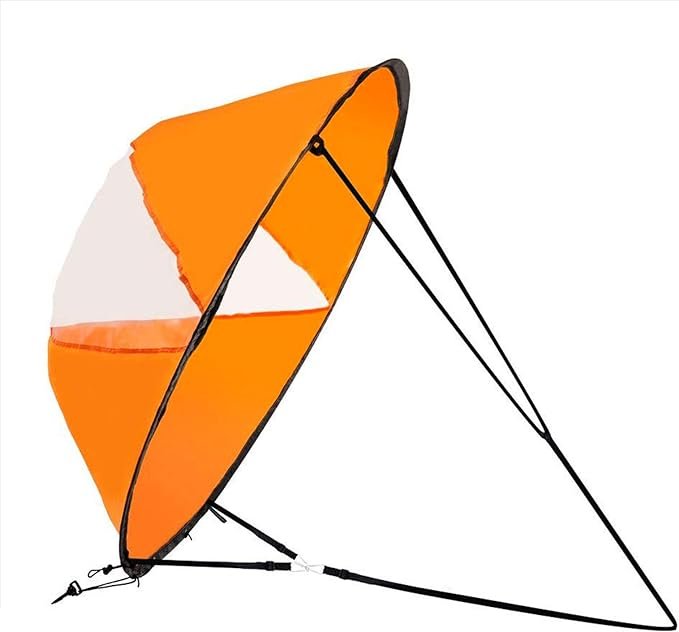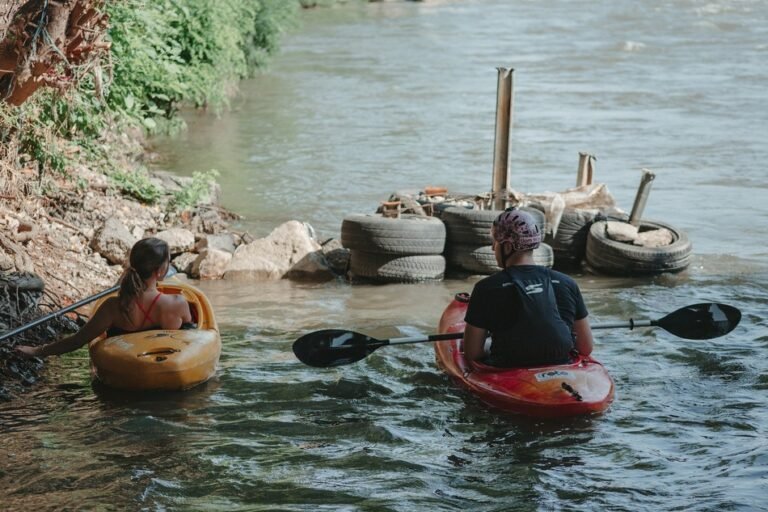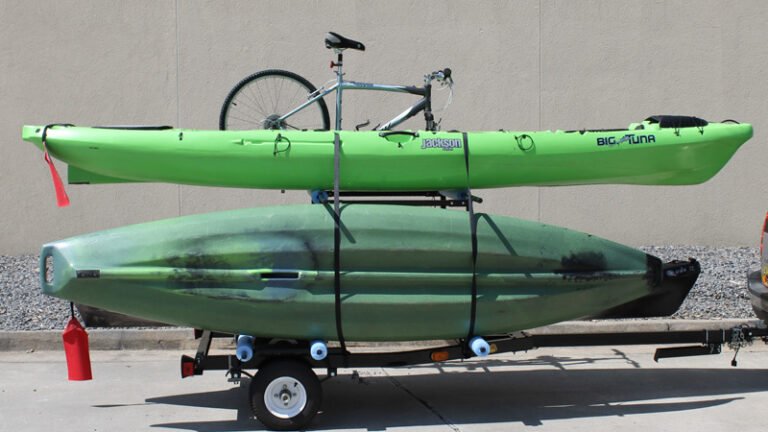Cómo portear un kayak
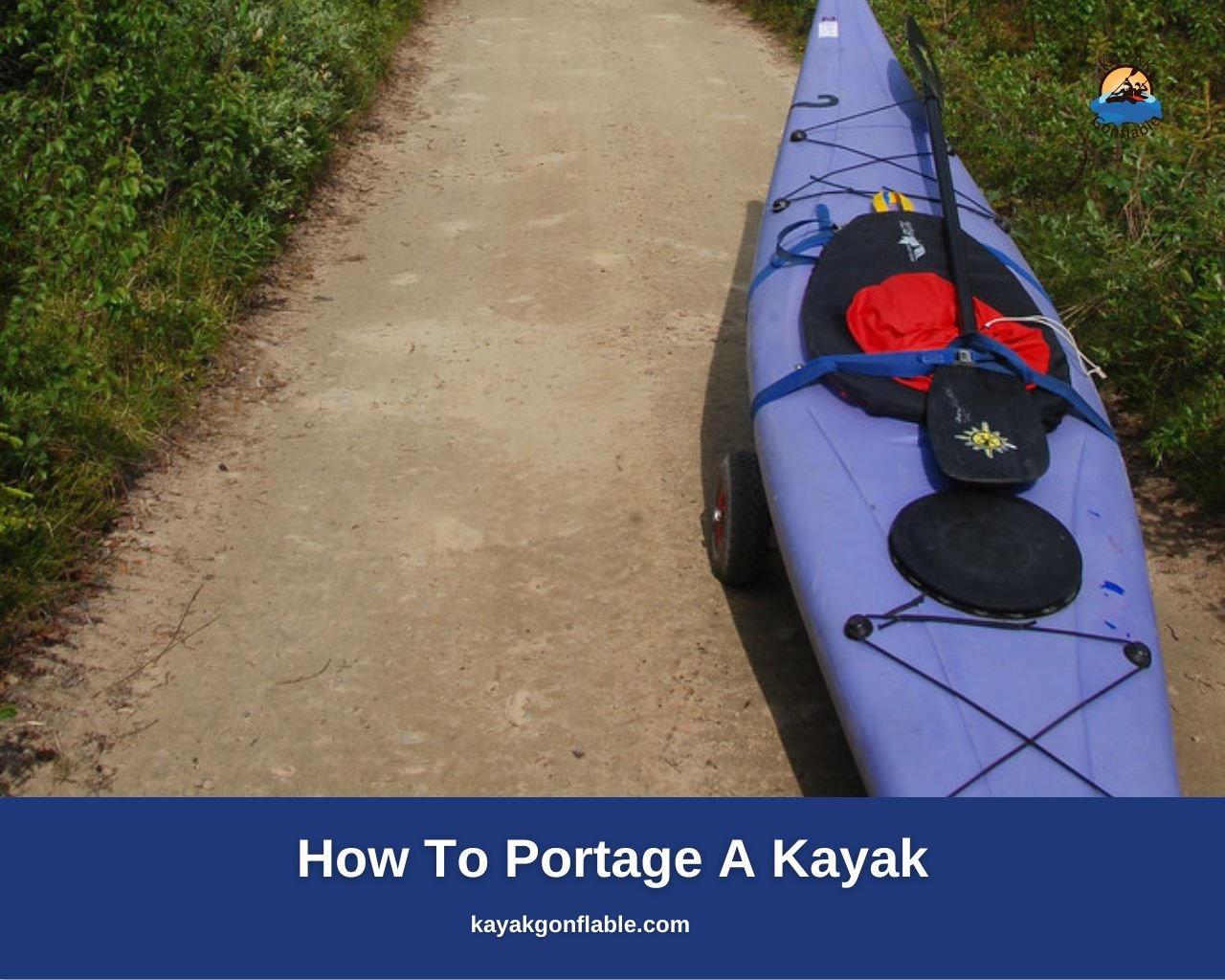
Hacer kayak es innegablemente divertido y una excelente manera de hacer ejercicio y ver hermosos paisajes. Sin embargo, los remeros a veces tienen que transportar sus embarcaciones de un punto a otro durante su viaje, y transportar un kayak puede ser un desafío ya que los kayaks suelen ser pesados y difíciles de transportar.
Este artículo le ayudará a abordar el transporte de su kayak desde otro ángulo para que su viaje sea más placentero.
¿Qué es la portabilidad?
Portaging es el acto de transportar mercancías o personas por vía terrestre entre dos puntos. Se puede realizar en un río o lago, así como en tierra.
El objetivo del transporte es reducir el número de viajes necesarios para llegar de un lugar a otro. Existen diferentes tipos de porteos, dependiendo del terreno.
El transporte es una técnica utilizada por piragüistas y kayakistas para transportar sus embarcaciones a través de ríos y lagos. Es una forma de sortear secciones de agua difíciles y también es una excelente manera de explorar nuevos territorios.
Los remeros a menudo se desplazan alrededor de acantilados, rápidos y otros obstáculos mientras llevan sus embarcaciones a la espalda.
¿Cuándo transportar un kayak?
Transportar un kayak es una forma popular de navegar por vías fluviales difíciles. Hay muchos factores a considerar al decidir cuándo transportar un kayak:
- La longitud del transporte (la distancia a cruzar le permite saber si vale la pena el transporte)
- El estado del agua (aguas turbulentas o rápidos suelen ser señales para transportar su embarcación)
- El tipo de kayak (esto trata sobre el peso del kayak y la mejor manera de transportar la embarcación)
- Su experiencia (la frecuencia con la que ha transportado una embarcación anteriormente le permite saber si esta vez está a la altura de la tarea).
Siempre debe consultar mapas locales y materiales de referencia antes de embarcarse en un transporte.
Transportar un kayak puede ser una excelente manera de ahorrar energía y tiempo cuando se viaja por vías fluviales difíciles, pero los terrenos complicados no son el único momento en el que hay que transportar su embarcación. Algunos casos en los que la portabilidad es necesaria incluyen:
- Trasladar tu kayak desde tu vehículo (coche, camión, etc) al agua o del agua a tu vehículo.
- Si el agua es demasiado profunda o se mueve rápidamente para que su kayak pueda navegar fácilmente.
- Si necesita cruzar un obstáculo difícil, como un río ancho o un lecho rocoso, es mejor cruzarlo por tierra.
- Si el agua es demasiado rocosa o poco profunda para su kayak.
- Si estás explorando un área remota.
- Si estás en una aventura donde navegas por diferentes cuerpos de agua que tienen rutas de transporte entre ellos.
Consejos para transportar un kayak
Antes de practicar kayak y necesitar transportar su embarcación en un viaje, debe tener en cuenta estos consejos.
1. Planifique su ruta con anticipación
Antes de emprender cualquier viaje, recopilar información sobre las rutas a seguir es fundamental, especialmente si llevarás cargas.
Debe explorar la ruta prevista, ya sea física o digitalmente, antes de embarcarse en su viaje. La exploración digital implica el uso de mapas y tecnología como sistemas GPS para obtener toda la información relevante sobre su ruta de transporte.
La exploración física, aunque considerablemente más difícil y agotadora que la versión digital, le brinda una mejor perspectiva no solo de la ruta de transporte sino también del punto de lanzamiento de su kayak una vez en el destino.
Explorar físicamente sin tu kayak también te da una idea de cuánto tiempo te tomaría en promedio mover tu kayak de un punto a otro y cuántos descansos debes tomar.
2. Quitar el agua del kayak
Transportar kayaks es un desafío porque los kayaks son inherentemente pesados, por lo que siempre debe drenar el agua que pueda haber entrado en su embarcación antes de transportar el kayak, ya que dicha agua le dificultará la tarea.
Los kayaks para sentarse en la parte superior se pueden drenar fácilmente del agua a través de los orificios de los imbornales, mientras que los kayaks para sentarse en el interior se pueden drenar de manera similar tirando de los tapones de los orificios de drenaje.
3. Retire el equipo innecesario
Así como el agua chapoteando en su kayak haría que el viaje de transporte fuera difícil e incómodo, dejar el equipo en su kayak aumenta su peso y dificulta el transporte.
Retire siempre todo el equipo innecesario y colóquelo en una mochila o bolsa seca para ayudar a reducir la carga en su kayak y facilitar el transporte.
También elimina el riesgo de que algunos equipos se caigan de la moto de agua al trasladarla de un lugar a otro.
4. Practica
Si quieres mejorar en el transporte de kayaks, una buena forma de hacerlo es practicar.
El dicho "La práctica hace la perfección" suena cierto aquí porque, como los kayaks son bastante pesados, practicar constantemente llevando tu kayak en casa le ayudará a desarrollar la fuerza y la resistencia necesarias para realizar fácilmente la tarea cuando vaya a transportar su kayak.
Puedes practicar el transporte de tu kayak en tu jardín o vecindario. Practique levantar la embarcación por encima de su cabeza para tener una idea de su peso y su equilibrio.
Muévase con el kayak para tener una idea de cómo transportarlo, teniendo en cuenta que lo más probable es que transportarlo durante un viaje sea más difícil. Si practicas lo suficiente, notarás que transportar tu kayak será bastante fácil cuando tengas que hacerlo en una ruta de transporte.
5. Sea consciente de su entorno.
Otro consejo importante es estar atento a tu entorno en todo momento.
Es fundamental estar atento al entorno para poder notar y evitar fácilmente todos los peligros posibles mientras transporta su kayak, especialmente cuando el terreno no es favorable y no está familiarizado con el área.
Sea cortés con otros kayakistas si los ve en la ruta mientras mantiene una actitud positiva y todo estará bien.
6. Empaque ligero
Si se embarcará en una aventura en kayak en la que tendrá que transportar la embarcación, considere empacar liviano y llevar solo el equipo esencial en su viaje.
Recuerde que los kayaks son pesados por sí solos y cuanto más equipo lleve consigo, mayor será el tiempo de transporte y es posible que tenga que realizar varios viajes en el peor de los casos.
Esto es peligroso ya que no todos en el camino pueden ser amables y algunos pueden ayudarse ellos mismos con su equipo.
Para tener un mejor control de tus pertenencias, es recomendable llevar solo lo necesario o lo que estés seguro de poder transportar junto con tu kayak en un solo viaje. Empacar ligero también le ayuda a ahorrar tiempo.
Cómo transportar su kayak
Utilice un carrito de kayak
El kayak no se trata solo de remar. A veces necesitas llevar tu kayak a una distancia corta y eso puede ser un desafío ya que los kayaks son bastante pesados y difíciles de transportar.
A carrito de kayak es una manera fácil de transportar su kayak. Los carros están diseñados específicamente para transportar kayaks y facilitan mucho el transporte de su embarcación. Puedes comprar un kayak. carro o construya uno usted mismo si lo desea.
Hay varios tipos de kayak carros en el mercado para atender a los diferentes tipos de kayaks disponibles. El carrito para kayak más común es el tipo plegable.
Este carrito tiene dos ruedas y se pliega para un fácil almacenamiento para que pueda continuar su viaje después de transportar su kayak. A continuación se presentan algunas razones por las que utilizar un carrito para kayak es una idea inteligente.
- Puede ayudarle a mover su kayak de un lugar a otro fácilmente y con el mínimo estrés.
- Un carrito para kayak te ahorrará tiempo y esfuerzo en tu viaje.
- Los carros para kayak se pueden utilizar en todo tipo de terreno mientras se transporta la embarcación, por lo que siempre son útiles.
- Los carros para kayak son especialmente útiles para personas con problemas médicos en la espalda, hombros, rodillas u otras dolencias que harán que transportar un kayak con fuerza bruta sea peligroso para ellos.
La próxima vez que su viaje en kayak incluya una ruta de transporte, considere adquirir un carrito de kayak para facilitarle el viaje.
Utilice las asas de transporte de su kayak
Muchos kayaks vienen con asas de transporte en la proa y la popa del barco y algunos incluso tienen asas en el costado del kayak para ayudar con el transporte.
Las manijas proporcionan un lugar conveniente para que el kayakista se sujete mientras mueve el kayak y permiten que dos remeros muevan fácilmente el kayak con un remo sosteniendo el mango de proa mientras el otro sostiene el mango de popa.
Las asas de transporte del kayak también pueden ser útiles si utiliza un carrito para transportar su kayak. Las asas le ayudarán a cargar fácilmente la embarcación en el carrito del kayak.
Debes cargar el kayak con la popa en el carro y luego usar las manijas de proa para tirar y dirigir el kayak y el carro. Esta combinación hace que sea una manera fácil de transportar su kayak.
Las asas de transporte realmente hacen la vida más fácil, ya que se pueden utilizar para transportar dos kayaks al mismo tiempo. Quizás esté con un amigo o familiar, cada uno de ustedes con su kayak y tenga que transportarlos a lo largo de una distancia.
Todo lo que necesita hacer es designar a un palista para que maneje las manijas de proa de los kayaks mientras que el otro palista se agarra de las manijas de popa de los kayaks y luego se mueve. Caminando a un ritmo que se adapte a ambos podrá ahorrar tiempo y transportar ambos kayaks fácilmente.
Sin embargo, debe tener en cuenta que, si bien este método es eficaz y ahorra tiempo, transportar dos kayaks de esta manera puede resultar agotador para el cuerpo, especialmente para la espalda y los hombros.
Si no tiene prisa o desea reducir la tensión en su cuerpo, puede transportar cada kayak por separado con una persona sosteniendo las asas en cada extremo de la embarcación. Sin embargo, recuerde que si bien la alternativa es menos agotadora para el cuerpo, también lleva más tiempo.
Usa la fuerza bruta
La última forma de transportar su kayak es mediante el uso de la fuerza bruta. Como su nombre lo indica, debes asegurarte de tener la fuerza necesaria para seguir este camino, por lo que este método no es para todos.
Aquí simplemente lleva su kayak sobre su cabeza y comienza la caminata hacia su destino. Como los kayaks son intrínsecamente pesados, este método te cansa fácilmente y puede suponer una tensión grave para el cuerpo, especialmente para la espalda y los hombros.
La ventaja de utilizar la fuerza bruta es que no necesitas equipo adicional (como un carro) para mover tu kayak de un lugar a otro.
Antes de emplear este método de transporte de kayak, es recomendable que ya hayas practicado esta forma de transporte en situaciones controladas para conocer tu nivel de resistencia.
El método tampoco es adecuado para terrenos largos o accidentados, así que téngalo en cuenta antes de optar por transportar su embarcación con fuerza bruta. Si debe utilizar la fuerza bruta, hágalo con precaución y asegúrese de hacer tantas paradas como sea necesario para transportar el kayak de forma segura.
El kayak es una excelente manera de salir al aire libre y disfrutar de la naturaleza. También puede ser un gran ejercicio. Sin embargo, si no estás familiarizado con el deporte, es importante que te tomes un tiempo para aprender los conceptos básicos antes de lanzarte al agua.
Esto incluye aprender a transportar un kayak. Explorar su ruta, practicar el transporte y ser consciente de la seguridad siempre debe estar en la mente de los kayakistas antes de embarcarse en un viaje que implique el transporte.
Para transportar un kayak, necesitará:
- Retire todo el equipo del kayak.
- Drena toda el agua del kayak.
- Levanta el kayak y llévalo a tu destino. Esto se puede conseguir con un carro, fuerza bruta o llevando el kayak por las asas con un compañero.
- Ser consciente de la seguridad en el camino para llegar allí de forma segura.
- Una vez en su destino, reemplace todo el equipo y continúe su viaje.
Recuerde practicar siempre técnicas de transporte seguras utilizando una correa resistente o un asa de transporte y manteniendo el equilibrio. ¡Diviértete en el agua!

